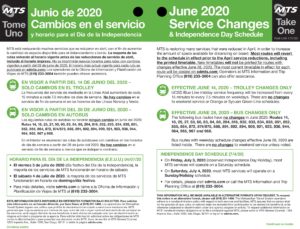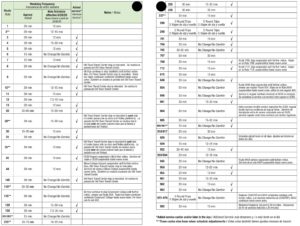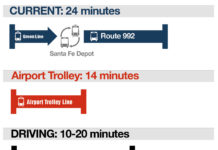Beginning Sunday, June 28, the Metropolitan Transit System (MTS) will increase frequency and/or span of service on 40 out of 95 bus routes in the system to accommodate growing demand for transit and help with physical distancing when possible. This increase puts service near pre-COVID-19 levels. The agency reduced its service by 25% back in April due to COVID-19.
“We want people to know that MTS is a safe and reliable way to travel,” said MTS CEO Sharon Cooney. “MTS has ramped up its efforts to disinfect vehicles and stations with the strongest CDC-recommended solutions and we’ve implemented many other best practices utilized by transit agencies across the U.S. Our increase in service is in response to the number of people who are returning to work and who depend on transit. Increasing service helps our riders achieve physical distancing.”
Ridership on the system is now averaging approximately 105,000 passenger trips per weekday on 95 bus routes and three Trolley lines. Prior to COVID-19 pandemic, MTS was gaining momentum with riders, averaging approximately 290,000 trips per weekday.
A full list of all the route changes can be found on the June Service Changes webpage.
Frequency and span improvements to notable high-ridership routes include:
Route 7 (Downtown – Balboa Park – University/College)
- Frequency improved to every 10 minutes (previously 12 minutes)
Route 11 (SDSU – Downtown)
- Frequency improved to every 15 minutes (previously 30 minutes)
Route 13 (Kaiser Hospital – Grantville Transit Center – Euclid Transit Center – 24th Street)
- Frequency improved to every 12 minutes (previously 20 minutes)
Route 30 (Downtown – Old Town – Pacific Beach – La Jolla – UTC)
- Frequency improved to every 15 minutes all day (previously 15-30 minutes)
Rapid 215 (Downtown – Balboa Park – Mid-City – SDSU)
- Frequency improved to every 10 minutes during peak commute times (previously 15 minutes all day)
Rapid 225 (Otay Mesa – Chula Vista – Downtown)
- Frequency improved to every 15 minutes during peak commute times (previously 30 minutes all day)
Rapid 235 (Downtown – City Heights – Rancho Bernardo – Escondido)
- Frequency improved to every 15 minutes (previously 30 minutes)
Route 929 (Iris Avenue Transit Center – 12th & Imperial Transit Center)
- Frequency improved to every 12-15 minutes all day (previously 15 minutes)
Route 933/934 (Imperial Beach – Iris Avenue Transit Center – Palm City)
- Frequency improved to every 12-15 minutes (previously 15-20 minutes)
Route 955 (National City – Euclid Transit Center – SDSU)
- Frequency improved to every 12 minutes (previously 20 minutes)
In addition to service increases, MTS also continues to improve its already-strict safety and sanitizing protocols.
Safe-travel guidelines/updates:
- Face coverings:
- All passengers are required to wear a face covering while using the transit system.
- Rear-door boarding:
- Passengers must board from the rear door on buses to increase distance between passengers and the bus operator. The exception is for persons with disabilities requiring the ramp
- Germ barriers around the bus driver seat are being installed to better protect bus operators. These barriers will allow the agency to return to front-door boarding which will give passengers more room to space out on board.
- Social distancing:
- While sitting, passengers should keep a 6-feet distance between each other and the bus operator when possible.
- New studies show that limiting conversations when traveling on transit also helps limit transmission of viruses.
- No-Contact Fare Purchase:
- Riders are encouraged to get bus or Trolley fares through the Compass Cloud app to minimize contact with machines, or other people. Cash is not accepted on bus, but fares are required to ride.
MTS continues to operate about 95 bus routes and three Trolley lines. Frequencies and spans have been restored to near-pre-COVID-19 levels. Updated schedules can be accessed on the MTS website. MTS asks that that people wear face coverings at all times and practice physical distancing when possible.






